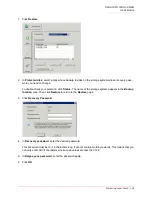
Serial ATA 4-Drive NAS
User Guide
Protecting Local Disks - 116
6. When the confirmation message appears, click
Yes
.
The disk or partition is recovered to exactly its state at the date and time of the selected backup.
To let you monitor the progress of this activity, the
Status
page appears automatically. The
Current
activity
area displays the percentage of the recovery that has completed, and the speed at which the
data is being sent over the network. The
Progress
bar graphically indicates how much of the recovery
is complete.
7. When you are prompted to restart the computer, click
OK
.
You do not need to restart your computer immediately, but you cannot access the recovered disk or
partition until you do.
As soon as you restart the computer, you must start DiskSafe Express and back up the recovered disk
or partition manually (as described in
“Manually Backing Up Your Disk”
on page 104) to resume pro-
tection. In addition, if you recovered a partition and any other partitions on the same disk were pro-
tected, you must manually back up those partitions as well.
Recovering a System Disk or Partition
To recover a system disk or partition using the recovery CD:
1. Using the appropriate procedure for your system, configure the computer to boot from the CD-ROM
drive.
2. Insert the recovery CD into the CD-ROM drive.
When responding to the prompts, use the arrow keys to highlight the desired item, use the space bar
to select or clear options (an
X
appears in the brackets when the option is selected), and press Enter to
make your selection. You can also tab between fields.
3. When the hardware list appears, select the network interface card (NIC) that you need to use when
recovering the data, and then select
Next
.
In most cases, there will be only one NIC, and you can simply select
Next
.
This screen displays only the NICs on this system that are supported by DiskSafe Express. If no NICs
appear on this screen, you might need to install an appropriate network driver. Select
Load Driver
,
select the location from which you need to install the driver (
Load From System
for the local hard
disk,
Load From Floppy
for a floppy disk drive, or
Load From CDROM
for a CD-ROM drive), insert
the disk in the drive (if loading from a floppy disk or CD-ROM), and respond to the prompts. For infor-
mation about obtaining the appropriate driver, contact your vendor.
To see a complete list of the detected hardware, select
Rescan
. When you are done viewing the list,
select
OK
.
Note:
You can cancel this operation at any time by clicking
Stop Current Activity
. However, this
will leave the local disk or partition in an incomplete state, and you will need to recover it
again before you can use it.
Summary of Contents for USR8700
Page 1: ...Serial ATA 4 Drive NAS User Guide R46 1702 00 rev 0 8 04 07 ...
Page 6: ...Serial ATA 4 Drive NAS User Guide vi ...
Page 8: ...Serial ATA 4 Drive NAS User Guide Safety Instructions 8 ...
Page 46: ...Serial ATA 4 Drive NAS User Guide Getting Started 44 ...
Page 86: ...Serial ATA 4 Drive NAS User Guide Managing Your Storage System 84 ...
Page 126: ...Serial ATA 4 Drive NAS User Guide Protecting Local Disks 124 ...
Page 136: ...Serial ATA 4 Drive NAS User Guide Disk Configurations 134 ...






























